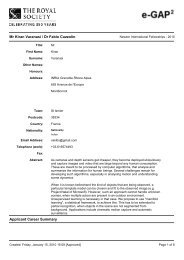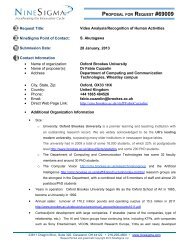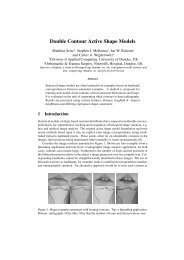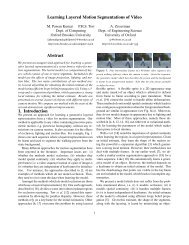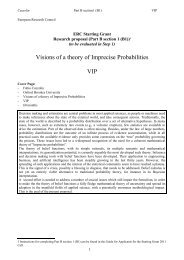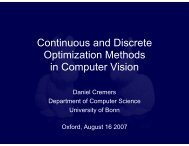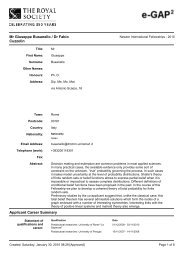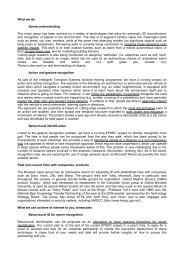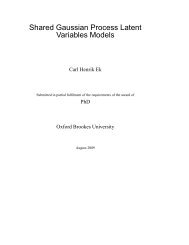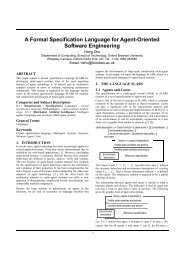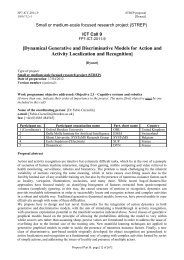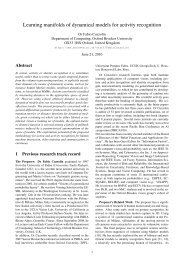Reconstructing relief surfaces - Oxford Brookes University
Reconstructing relief surfaces - Oxford Brookes University
Reconstructing relief surfaces - Oxford Brookes University
Create successful ePaper yourself
Turn your PDF publications into a flip-book with our unique Google optimized e-Paper software.
400 G. Vogiatzis et al. / Image and Vision Computing 26 (2008) 397–404<br />
configurations of base surface and sample points (Fig. 1<br />
right).<br />
3. Optimisation<br />
The MRF model laid out in the previous section provides<br />
a probability for any possible height labelling and<br />
corresponding <strong>relief</strong> surface. MRF inference involves<br />
recovering the most probable site labelling which is an<br />
NP-hard optimization problem in its generality [15]. Fortunately<br />
a number of efficient approximate algorithms have<br />
been proposed such as graph cuts [1] and belief propagation<br />
[24]. These methods have been shown to give very<br />
good results in a depth-map setting (see [21,25] for a comparison).<br />
In this work we choose to apply a belief propagation<br />
scheme which we outline in the following section.<br />
3.1. Loopy belief propagation<br />
Belief propagation works by the circulation of messages<br />
across neighbouring sites. Each site sends to each of its<br />
neighbours a message with its belief about the probabilities<br />
of a neighbour being assigned a particular height. The clique<br />
potentials<br />
UkðhkÞ ¼exp ð CkðhkÞÞ<br />
ð5Þ<br />
and<br />
Wklðhk; hlÞ ¼exp ð Cklðhk; hlÞÞ<br />
ð6Þ<br />
are precomputed and stored as L · 1 and L · N matrices,<br />
respectively. Now suppose that mij(hj) denotes the message<br />
sent from sample point i to sample point j (this is a vector<br />
indexed by possible heights at j). We chose to implement<br />
the max-product rule according to which, after all messages<br />
have been exchanged, the new message sent from k to l is<br />
emkl ¼ max UkðhkÞWklðhk; hlÞ<br />
hk<br />
Y<br />
mikðhkÞ: ð7Þ<br />
i2NðkÞ flg<br />
The update of messages can either be done synchronously<br />
after all messages have been transmitted, or asynchronously<br />
with each sample point sending messages using all<br />
the latest messages it has received. We experimented with<br />
both methods and found the latter to give speedier convergence,<br />
which was also reported in [25].<br />
3.2. Coarse to fine strategy<br />
One of the limitations of loopy belief propagation is that<br />
it has significant memory requirements, especially as the<br />
size of the set of possible heights is increased. In the near<br />
future bigger and cheaper computer memory will make this<br />
problem irrelevant, but for the system described in this<br />
paper we designed a simple coarse to fine strategy that<br />
allows for effective height resolutions of thousands of possible<br />
heights. This strategy effectively, instead of considering<br />
one BP problem with L different labels, considers<br />
logL/logl problems with l labels where l L. It therefore<br />
also offers a runtime speedup since it reduces the time<br />
required from O(ML 2 )toO(logL Ml 2 /logl).<br />
Initially the label set for all sites corresponds to a coarse<br />
quantization of the allowable height range. After convergence<br />
of the Belief Propagation algorithm each site is<br />
assigned a label. In the next iteration a finer quantization<br />
of the heights is used within a range centered at the optimal<br />
label of the previous iteration. The label set is now allowed<br />
to be different for each site. At each phase the number of<br />
possible heights per node is constant but the height resolution<br />
increases.<br />
To make this idea more precise, at this point we replace<br />
height labels with height range labels. A sample point can<br />
now be labelled by a height range in which its true height<br />
should lie. The cost for assigning height interval [Hi,Hi+1] to the kth site is now defined as:<br />
^Ck ð½Hi; H iþ1ŠÞ<br />
¼ min CkðhÞ: ð8Þ<br />
h2½H i;H iþ1Š<br />
In practice this minimum is computed by densely sampling<br />
Ck(h) over the maximum range [Hmin,Hmax] so that the<br />
images are all sampled at a sub-pixel rate. This computation<br />
only has to be performed at the beginning of the algorithm.<br />
Similarly the smoothness cost for assigning height<br />
ranges [Hi,Hi+1], [Hj,Hj+1] to two neighbouring sites k<br />
and l is:<br />
^Cklð½H<br />
H i þ H iþ1<br />
i; H iþ1Š; ½H j; H jþ1ŠÞ ¼ Ckl<br />
;<br />
2<br />
H j þ H jþ1<br />
:<br />
2<br />
ð9Þ<br />
When belief propagation converges, each point is assigned<br />
an interval in which its height is most likely to lie. This<br />
interval will then be subdivided into smaller subintervals<br />
which become the site’s possible labels. The process repeats<br />
until we reach the desired height resolution.<br />
4. Results<br />
In this section, a quantitative analysis using an artificial<br />
scene with ground truth is provided. Results on a challenging<br />
low-<strong>relief</strong> scene of a Roman sarcophagus, a building<br />
facade and a stone carving are also illustrated. The weight<br />
parameters w 1 and w 2 of Eqs. 3 and 4 are empirically set<br />
relatively easily after a few trial runs. However, in cases<br />
where the distributions of . and dkl are known (e.g., we<br />
are given ground truth data for a similar scene), the weights<br />
can be set by using the approximation of [9] where the clique<br />
potentials are fitted to the distributions of . and dkl.<br />
4.1. Artificial scene<br />
The artificial scene was a unit sphere whose surface was<br />
normally deformed by a random displacement and texture<br />
mapped with a random pattern (see Fig. 2). The object was<br />
rendered from 20 viewpoints around the sphere. Using the<br />
non-deformed sphere as the base surface on which 40,000<br />
sample points were defined, the <strong>relief</strong> surface MRF was



